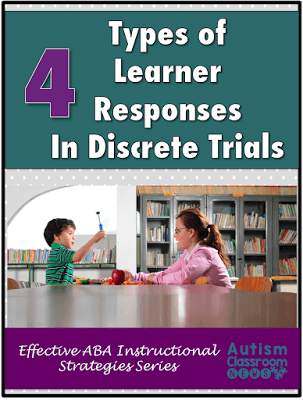After the instruction, presenting the materials, and the prompt (if needed), our next step in a discrete trial is the learner’s response. I talked last time about creative ways to have students respond to shake up instruction. Today I want to talk about how we classify responses.
Essentially there are 3 types of responses that a student can give you in response to the instruction (and prompt if needed), but there are 4 ways we might categorize those responses based on whether we had to give a prompt. I won’t spend vast amounts of time talking about them because they are pretty obvious. However, I do have “soapbox” items to share about them in the way I think about classifying response. And determining what type of response you are getting is critical to determining the consequence (i.e., whether you reinforce, whether you correct, etc.).
1. Correct, Independent Response
I included correct and independent together because it is always possible to have the opposites (i.e., correct-prompted and incorrect-independent). However, I’m going to put those in a different category. Some folks will differentiate between a correct response and a correct, independent response. This means that they will count a response as correct even if it was prompted. I don’t and here’s why.
Unless I am using an elaborate prompting strategy, to me a response is not fully correct if it is prompted. I count a response that has been prompted as a prompted response and assume that a correct response is independent. To me, a correct response means that the student is mastering the skill. If the skill is still being prompted, the student hasn’t mastered it and, depending on the prompt, may not be able to do it at all correctly without assistance. My ultimate goal is independence, so to me if it’s not independent, it’s not correct. Are there exceptions to this? Sure, but overall this is how I conceptualize the responses. A correct, independent response is the goal and gets reinforcement in some way (more about that later).
2. Prompted Response
I see no reason to separate out prompted correct from prompted incorrect. I would hope that if we are prompting the student, we are doing it effectively and the student is giving us a correct response. If not we are doing something wrong. Typically I will record in my data what level of prompting was needed, but essentially a prompted response is one that you prompted and the student responded to the prompt correctly.
3. No Response
Obviously if we give a direction and give a prompt and the student does not respond, we got no response. If we are using prompting strategies effectively, then we should be able to get a response. However, sometimes the student fights us, or we are trying to fade out the prompts and the result is that the student does not respond at all. I don’t want more than 1 no response trial in a row during my trials, so if I don’t get a response, something is going to change in the next trial (e.g., I’ll give a prompt, I’ll make it easier, I’ll be extra sure to have his/her attention).
4. Incorrect Response
If we are using errorless teaching (where we use prompting to avoid students getting incorrect responses), we shouldn’t see many of these. However, in verbal trials (e.g., I ask a student to name a picture), we can prompt the right answer verbally but we can’t physically prompt the correct response, so sometimes we will see these in those types of trials. Like with the no response trials, we don’t want more than 1 incorrect response to occur consecutively in a set of trials, so we are going to change what we are doing on the next trial to avoid getting an incorrect response again. Too many incorrect responses have the student practicing the wrong thing and can be frustrating if we are using an error correction procedure to tell them no or correct them.
We’ll talk more about possible consequences for these types of trials in the next post of the series. For right now I’m going to try to post series posts on Thursday/Friday each week so you’ll know where to find them. I also will put together a flow chart at the end of the parts of discrete trials that you can share with staff as a reminder so stick with me. 🙂





![Summer resources to help survive the end of the year in special education [picture-interactive books with summer themes]](https://autismclassroomresources.com/wp-content/uploads/2018/05/SUMMER-RESOURCES-ROUNDUP-FEATURE-8528-768x768.jpg)

